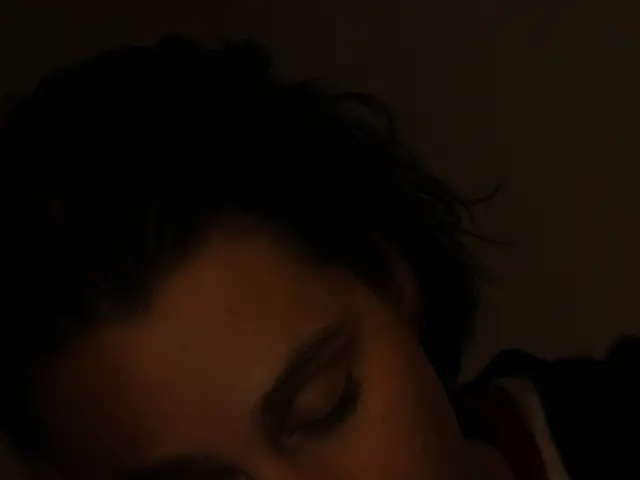Right side headache: Understanding origins, significance, and swift remedies
Headaches on One Side: A Comprehensive Guide
Experiencing headaches only on one side of your head? Here's what you need to know about the possible causes, types, and remedies for this common issue.
Why Does One Side Hurt?While some conditions cause headaches that affect both sides, others are more likely to yield pain on a single side. Let's explore some of the main culprits for one-sided headaches.
Conditions Causing Unilateral Pain
- Temporal arteritis: This inflammation of the temporal artery can cause fatigue, jaw pain, and tender temples, often only affecting one side [1].
- Trigeminal neuralgia: This disorder affects the trigeminal nerve, causing intense facial pain that usually targets one side at a time [1].
- Sinus headaches: People with a deviated septum are more likely to experience sinus headaches on a single side [2].
Conditions Affecting Both Sides But Can Be Localized
- Occipital neuralgia: Occurring when the occipital nerves become damaged or inflamed, this condition usually affects both sides, but can manifest as one-sided symptoms [2].
Common Causes of Headaches
- Allergies
- Infections, including sinus infections
- Fatigue
- Head injury
- Aneurysm
- Dehydration
- Muscle strains or knots in the neck
- Tumors
Medication Use and HeadachesHeadaches can also be a side effect of prescription or over-the-counter medications, particularly when these medications are overused. This type of headache is known as a medication-overuse headache and can lead to migraines or tension headaches [2].
What Are the Different Types of Headaches?With over a hundred types of headaches, it's essential to know the common ones that might be affecting you.
- Migraine: Genetics play a role in migraines, which cause severe symptoms, such as pulsating or throbbing pain on one side, blurred vision, nausea, sensitivity to light and sound, and vomiting [2]. Although migraines can occur on one side, they may switch sides from episode to episode.
- Cluster Headaches: These intense, one-sided headaches occur in cyclical patterns, usually around one eye. They may also radiate to other areas of the head, face, neck, and shoulders. People typically experience frequent headache attacks for weeks or months before a period of remission [3].
- Tension Headaches: These are the most common type of headache, affecting around 1 in 5 individuals. Although they usually affect both sides, they can occasionally be felt on only one side [2].
When to See a DoctorThough many headaches resolve on their own, it's crucial to consult a healthcare professional if headaches are severe, frequent, or worsening. Seek immediate medical attention if you experience vision changes, confusion, fever, head injury, increased pain during movement, neck stiffness, numbness, personality or cognitive changes, rash, sleep disturbances, slurred speech, or weakness [2].
One-sided headaches may indicate various conditions; however, if headaches consistently affect the same side, it's essential to get a medical evaluation.
[1] Mayo Clinic. (2021). Temporal arteritis (giant cell arteritis). https://www.mayoclinic.org/diseases-conditions/temporal-arteritis/symptoms-causes/syc-20353889[2] National Headache Foundation. (2021). Headaches symptoms and causes. https://www.headaches.org/2018/03/20/headache-symptoms-and-causes/[3] National Institute of Neurological Disorders and Stroke. (2020). Cluster headache. https://www.ninds.nih.gov/Disorders/All-Disorders/Cluster-Headache-Information-Page[4] American Migraine Foundation. (2021). Types of headaches. https://americanmigrainefoundation.org/resource-library/types-of-headaches/[5] American Physical Therapy Association. (2020). Cervicogenic headaches. https://www.moveforwardpt.com/SymptomsConditionsDetail.aspx?sid=9d5ce4ed-ee65-4a1a-9080-0a21d7ee1362#:~:text=Cervicogenic%20headache%20is%20a%20type,the%20neck%20or%20cervical%20spine.
- A person with a predisposition towards migraines might experience frequent, one-sided headaches, because genetics play a role in their occurrence.
- Some nasal conditions, such as sinus inflammation or polyps, can predispose individuals to sinus headaches on one side, often affecting only one nasal passage.
- The established medication Qulipta is designed to treat chronic migraines with or without aura, providing relief for people whose headaches severely impact their daily functioning.
- Migraines can affect people of all ages and genders, including those with a history of regular sleep disturbances, which can strain the body and predispose them to neurological disorders.
- The science of headache studies has recognized the importance of understanding the role of mental health, sexual health, and autoimmune disorders in the development and management of headaches and other related medical conditions.
- In many workplaces, there has been an emphasis on workplace-wellness programs, which aim to improve employees' overall health and wellness and potentially reduce instances of migraines and other physical ailments.
- Cancer, respiratory conditions, digestive health issues, and eye problems can cause or contribute to headaches, emphasizing the need for proper management of these medical conditions for individuals experiencing persistent one-sided headaches.
- Hearing loss, imbalances in health and wellness, fitness and exercise, and skin conditions have all been found to be associated with an increased risk of headaches in some populations.
- The misconceptions surrounding migraines and their naive treatment can lead many treaters to overlook the underlying causes, exacerbating the condition and prolonging the time it takes for patients to find relief.
- Aging, women's health, and men's health are essential considerations when assessing a person's susceptibility to both acute and chronic headache conditions.
- Migraines and cardiovascular health are closely linked, with migraines being a risk factor for the development of other cardiovascular diseases.
- Medications like aspirin and ibuprofen, when overused, can lead to medication-overuse headaches, which can progress to chronic migraines, tension headaches, or even a combination of both.
- Some people may find alternative therapies and treatments, such as biofeedback or stress management techniques, to be more effective in managing their headaches, as opposed to traditional pain relievers.
- A person with a personal history of untreated or improperly managed migraines may be more likely to develop more severe headaches, including cluster headaches, which are characterized by intense, one-sided pain.
- The combination of headaches and stress can create a vicious cycle, with headaches contributing to stress and stress in turn exacerbating the frequency and intensity of headaches.
- Modern science continues to explore the link between mental health disorders, such as depression and anxiety, and its impact on headache susceptibility and severity.
- Sleep disorders, like sleep apnea, may increase the likelihood of chronic headaches, demonstrating the importance of getting proper rest and addressing any underlying sleep issues for comprehensive headache management.
- The growing acceptance of CBD as a natural remedy has led to an interest in its possible benefits for migraine relief, with some research suggesting that CBD may help reduce headache frequency and intensity.
- Parenting can be stressful and strenuous, putting new parents at a higher risk for developing migraines or exacerbating pre-existing headache conditions due to disrupted sleep patterns and increased stress levels.
- Weight management is an essential component of any headache management plan, as being overweight or obese can put additional strain on the body, potentially increasing the likelihood of headaches and other related health issues.








